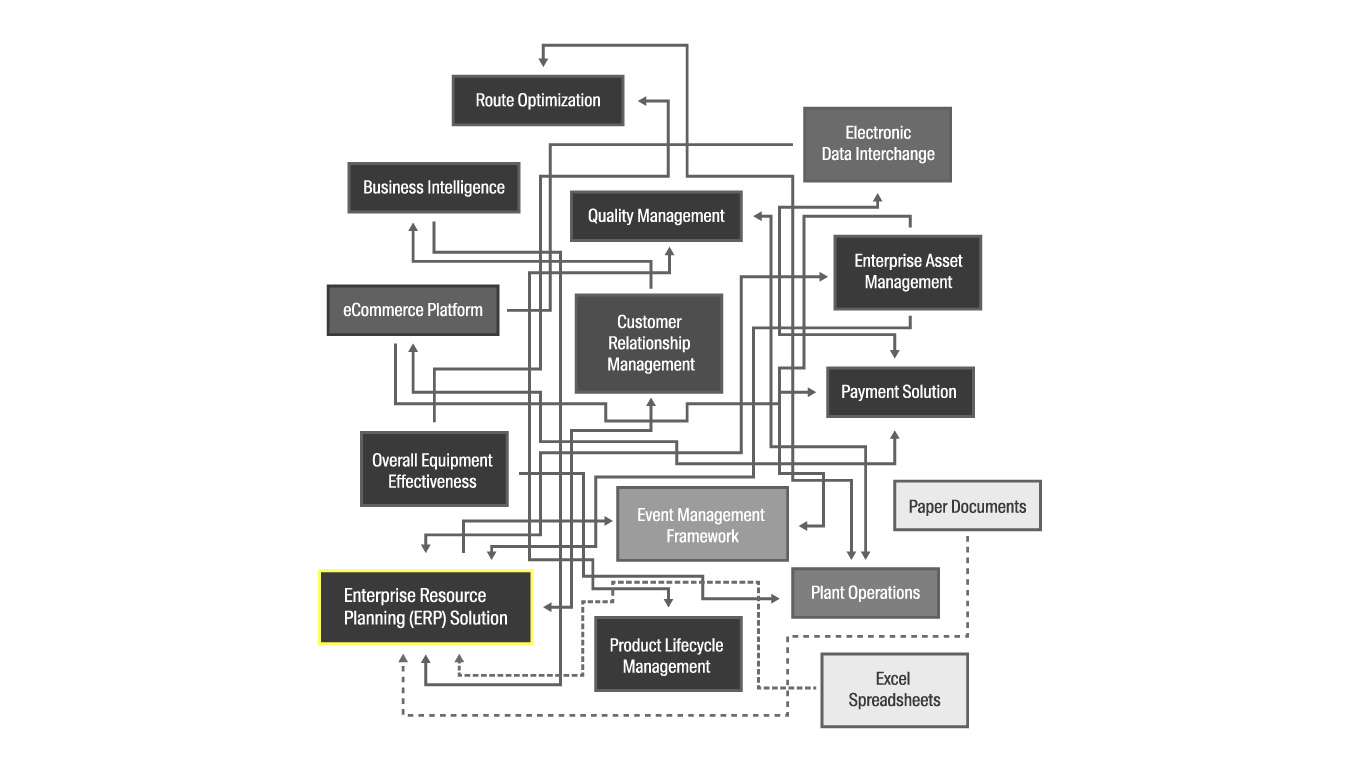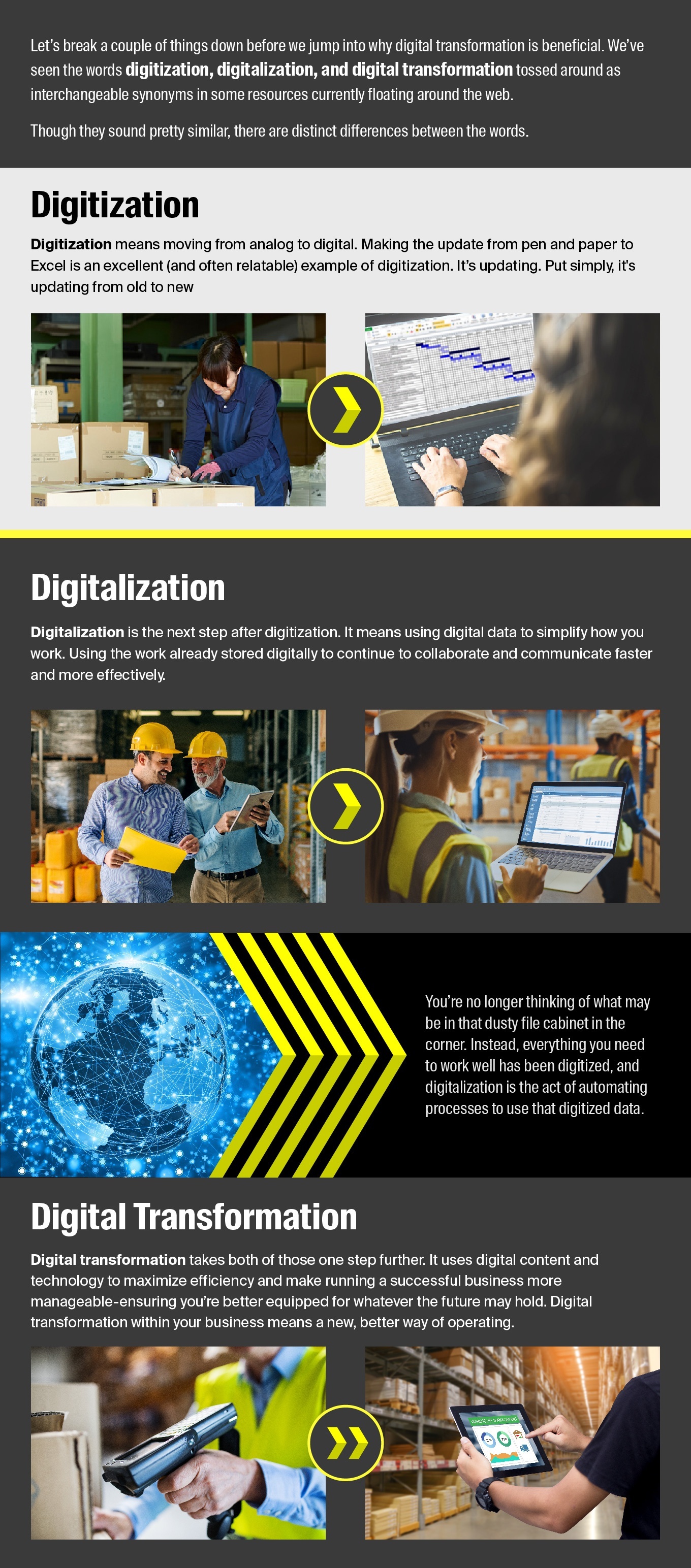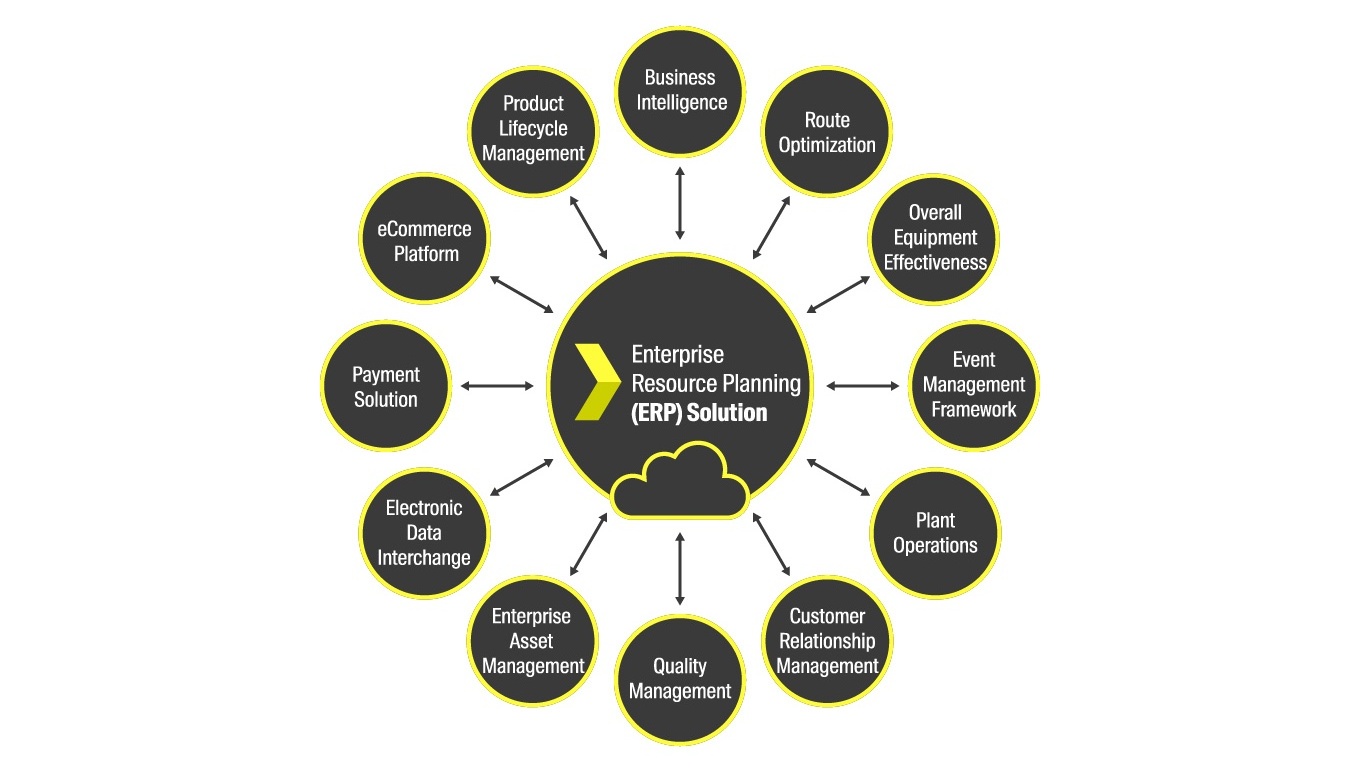Destacado en este post
The Ultimate Digital Transformation Guide
The Ultimate Digital Transformation Guide
Jun 22, 2021
 Aptean Staff Writer
Aptean Staff Writer 
Introduction
A journey of a thousand miles begins with a single step. - Lao Tzu
But it's a journey that's absolutely worth it.
At least that's what we think. Particularly when it comes to digital transformation.
Depending on who you ask, digital transformation can mean a lot of different things. For us, digital transformation means combining the best cloud software to create an environment that enables good people to do good work.
With digital transformation, you're using technology to change the way you operate—create more efficient business operations, challenge "the way it's always been done," and increase your opportunities for success.
But what EXACTLY does that mean? That's what this guide is for. To answer all those questions you may have about digital transformation.
What Is Digital Transformation?
As the name implies, digital transformation means harnessing the power of comprehensive, modern solutions to improve the efficiency and effectiveness of your operations across multiple functions and departments. Using technology to implement new (or enhance existing) processes and create a cultural shift that enables you to boost performance, better serve your customers and future-proof your business.
Let's be very clear, though. You can have all the newest, fanciest, most expensive tools, but if they're not entirely integrated, if your team isn't on board or if you're not actually willing to change, transformation is going to be tough.
Why Digital Transformation Is Better Than the Status Quo
Right now, a lot of businesses operate with point-to-point integration. This is the antithesis of digital transformation.

With a point-to-point model, your systems, as they are, have a hard time communicating. There's no practical way to exchange data. So when you need to share information with an external B2B partner, for example, a massive amount of data is generated. All because it isn't stored where it's created. Rather your data is siloed in a bunch of different places.
And that's when the real issues start. When several of your applications need that data to run well, when they aren't integrated, there's no way to share that data efficiently. There are roundabouts and duplications.
There's no single source of truth.
Which makes it that much harder to know what data is current, what data is accurate. It's tough to be confident in your decision-making when you don't see the truth behind your data. You don't know where it is, and you can't easily manage it. Which means you're going to inevitably struggle to integrate independent projects, create efficiencies, streamline operations, and pull cohesive, accurate reports.
This is why digital transformation is essential.
At the end of the day, not only are you able to run more efficiently internally, but you're able to meet your customers' needs more successfully. Digital transformation improves the foundation you've laid to grow and foster your relationships with your customers for life.
70% of companies either have a digital transformation strategy in place or are working on one. – Tech Pro Research
Digitization, Digitalization, Digital Transformation—What's the Difference?

What Are the Benefits of Digital Transformation?
There are lots of advantages of digital transformation. But the highest among them is a fully-integrated operating system. Because when you have a single source of truth, you get clear communication, cohesion, and maximum efficiency when you have all your data stored in one place. For both you and your customers.
A business that has gone through a digital transformation journey operates on an integrated hub-and-spoke model.

With a hub-and-spoke model, you're able to execute so much more than you could with point-to-point integration. You can:
Connect your technologies. All your technologies, no matter what they are—enterprise resource planning (ERP), product lifecycle management (PLM), electronic data interchange (EDI), customer relationship management (CRM), or anything in between—can talk to each other seamlessly.
Create a single source of truth. Your data is centralized and updated in real-time. Everyone is working off of the same information—eliminating opportunities for data inaccuracies.
Enhance efficiency. Digital transformation creates efficiency. It's not about the newest, most expensive technology. It's about getting the right tools to work together in the right way based on your business needs.
Boost productivity. Your team now has the tools to work better. You've enabled them to be successful, which is valuable in and of itself. But you've simultaneously created an environment and infrastructure poised for operational success, as well.
Streamline communication. Because you're working from a single source of truth, all the information you need is in a single place. You have visibility into all of your data and business operations. No longer do you have to dig through a filing cabinet, search your inbox, look for a sticky note or open up the tenth iteration of an Excel spreadsheet.
Improve customer service. Your products and services are reliable, and the customer experience can be whatever you'd like it to be. You can create automated processes, a personalized customer experience, and a robust online presence.
Future-proof your business. Digital transformation means you have the tools to tackle the industry as it is and the challenges that may appear tomorrow. You can scale as your business does, and you can do this easily. You already have everything you need.
When your business runs easier internally, you can focus more on building customer relationships and increasing profits.
Digital transformation is expected to add $100 trillion to the world economy by 2025. – World Economic Forum
$100 trillion. That's what a single source of truth can do for you. That's what efficiency can do for you. That's what equipping the right technology can do for you.
Overcoming the Challenges of Digital Transformation
To avoid the most common digital transformation pitfalls, preparation is critical. As are realistic expectations.
When we talk about the biggest barriers to digital transformation, we're generally talking about two key challenges: inadequate preparation and resistance to change.
87% of companies think digital will disrupt their industry, but only 44% are prepared for potential digital disruption. – Deloitte
The process of digital transformation takes as long as it takes. And we urge you not to rush the process. Or underestimate the complexity. It's a big project, a vast undertaking. So taking the time to create and execute the right roadmap for your company is the only way to secure your ultimate success.
One other main digital transformation challenge: the idea of change itself.
70% of digital transformations fail due to resistance from employees. – Mckinsey
It is tough to change. And some people are better at it than others. Know your employees may be reluctant, may be scared. As a leader and decision-maker, it's part of your responsibility to care for the well-being of your employees. Involve them in the process and keep everyone updated on the plan, progress and long-term strategy. They need to feel involved and invested in the outcome.
If you don't know how to do that, further down in this post, we explore how to involve your teammates (and not just those in leadership positions) in the digital transformation process.
Creating a Realistic Digital Transformation Roadmap
When starting on your digital transformation journey, it's often frustrating that there is no rulebook, no one-size-fits-all process, no standard recipe for success. And sure, that's daunting, but it's as it should be.
Your journey is as unique as your business, so your digital transformation process will look different from your competitors. And it should.
You want to digitally transform your organization in a way that will actually suit the needs of your business. And that starts with meticulous planning and realistic expectations.
It's all about creating a robust and structured plan based on your business goals and then making confident decisions to get you there. Before you can begin the transformation process and know whether the goals you're setting are realistic or not, you must first determine your starting point.
The starting point. This means conducting a cross-functional assessment of your current way of operating—existing systems and processes, their effectiveness, and the resources and tools you need to maintain them. By performing this kind of in-depth audit across your business, you can determine what's truly effective and what you may want to consider changing. Some questions worth asking to help create your digital transformation roadmap: - Is each system on-premise or in the cloud? - Do we have a single source of truth? - How can we improve the customer experience? - Where are we missing insight and visibility? - Are our systems well integrated? - Which vendors do we currently work with? - Do our vendors support our business goals? - What processes are most challenging for us? - What processes are easiest for us? - Where do processes differ between departments? - What processes can we look to automate, both within and across departments? - What tools do we have that we no longer need/use? - What tools should we look to add to improve operations/processes? - Where do we make most of our money? - Where do we lose most of our money? In answering all these questions, you'll be able to determine how to best transform your business—which tools are most important, which processes need to be implemented (or eliminated), and how you and your team can best work together to achieve your goals. When figuring out your starting point, you really should appoint an internal team. Include teammates from all departments with different job functions and experience. That way, when you're trying to clarify critical priorities throughout the entire organization, you have feedback from all departments and all people who will be affected. We also encourage you to survey all your employees to determine which features and functionalities will make you a stronger organization. Not only does this guide you on your path, but it also ensures all your employees feel included and heard from the outset. This will be critical in reducing resistance to change and improving employee adoption of any new technologies or procedures you may implement during the digital transformation process.
The destination. Now that you've figured out where you're starting, it's time to figure out where it is you want to go. What exactly do you want out of the digital transformation journey? What are your goals? When all is said and done, what do you see for your business? What does it look like? In deciding what exactly your destination is, you must identify priorities that align with your strategic plan and then work with your vendor(s) to determine how technology can support your strategy. Use the feedback provided by your teammates from all departments to guide you in deciding your destination.
The roadmap. Now you need to develop a plan that takes you from your starting point to your determined destination. Easy, right? It doesn't have to be as challenging as it sounds. You just need to ensure that as you work your way to becoming a digitally-transformed company, make sure the stops you have to take are value-adding. When you begin this journey, you need to consider what your long-term and short-term goals are. You must figure out which solutions and capabilities you need first and which ones can be phased in later. This makes prioritizing the waypoints on your roadmap easy—the highest priorities, the actions that will make the biggest difference. They're the ones that come first. To effectively navigate your path and accurately map your journey, we encourage you to sit down with your enterprise resource planning (ERP) software vendor and make a timeline. Often, a cloud-based ERP is at the heart of the digital transformation journey. It’s the centralized database that other technologies integrate with. And because it’s so central, you want to include your vendor in the process. Not only will this help you monitor your expectations and reach your targets within a timely manner, but it'll help you to acknowledge that this is a process. It will take time, and it will require you and your team to be agile and flexible. The fact that you're taking the steps necessary to strategically plan your digital transformation journey puts you ahead of the competition. A lot of companies are talking about it and claim to be working on it. Really, most companies are using technology to modernize their existing business model instead of transforming it. But you'll actually be doing it. You're changing the way your business works. And for the better, too.
Digital Transformation Metrics to Measure
If you're going to do something as big as transform your business, you need to have some key performance indicators (KPIs) to measure to ensure that you are, in fact, growing your business in the ways you want.
We have five digital transformation metrics we suggest you measure. And when it comes to KPIs, these should be measurable and explicitly focused on the goals you set out to achieve in your destination planning.
Operational improvement. With digital transformation, you're not just buying one piece of software or one new kind of technology. It's an integration, an investment in many tools. Tools that work together to make your business run more effectively and efficiently. For each digital investment you make—whether that's a cloud ERP, business intelligence, online payments, electronic data interchange, or anything in between—you should measure the impact of that investment. Because if you're doing this right, each investment you make should support the broader goals of your strategy, the destination you selected in your planning. When we talk about productivity indicators, generally, you should be able to measure the value and volume of outputs against the time, resources and money invested.
Customer satisfaction. Streamlined processes and real-time information mean more accurate customer orders, more time to focus on customers, and more time cultivating business. This can be measured with a net promoter score (NPS) and a customer satisfaction index.
User engagement. You want your digital transformation to make the lives of those that use the technology easier. If your employees and teammates aren't engaging in the way you want, it's likely because the software isn't meeting their needs. This is why it's essential to involve employees from all departments and leadership positions in the decision-making process. You can measure this with an NPS or engagement survey.
Reliability. If you've decided to embark on digital transformation, you were likely working on legacy systems and manual processes that used a point-to-point model. The implementation of new technology and tools should mean the availability and reliability of the system. There should be less downtime, fewer delays and fewer technology performance issues. These are metrics worth measuring.
New revenue from investments. It's invaluable that you measure the amount of new revenue credited to your just-made digital investments. It's the only way to make sure it's actually worth it. We think it is, but don't just take our word for it, run the numbers yourself.
Choosing the Right Digital Transformation Partner
Less than 30% of the organization's technology vendors are currently active vendors in their digital transformation initiatives. And this is even though partnering with vendors is one of the best practices to avoid failure. – Futurum
Let's repeat that last bit for emphasis: partnering with vendors is one of the best practices to avoid failure.
So you need to partner with a vendor that can support your success—every step of the way.
A vendor that knows your industry, has a strong track record and experience helping companies with digital transformation, is cloud-focused, provides ongoing support, stays at the forefront of industry demands with innovative solutions, and can offer all the solutions you may need along the way so that you don't have to go to different vendors for support and add-ons.
You've done the hard work. You've decided on change, on growth, on transformation.
Let us help you do the heavy lifting.
Because only when you succeed do we succeed.
We're a partner that puts your business growth at the forefront, that knows your industry from the inside out. Because we've been there. And we'll stop at nothing to solve your problems, help you overcome your challenges and pave the way on your path to success.
We work with our customers on the right digital transformation strategy, path and manufacturing software solutions to help them modernize and grow their business. We can help you do the same.
Ready to begin your digital transformation journey? Reach out, now.
¿Todo listo para transformar tu negocio?
Tenemos el software especializado en tu sector que ayudará a tu organización a prosperar.



